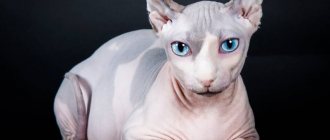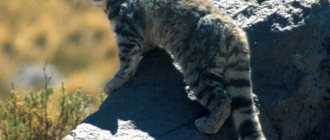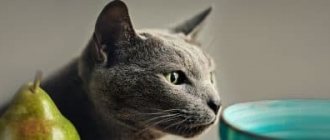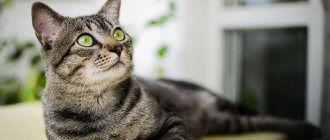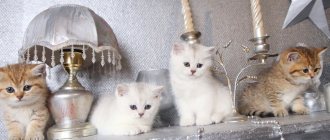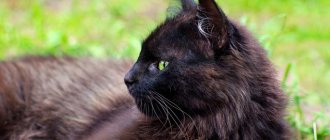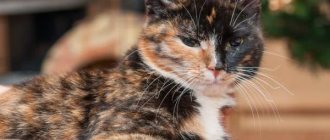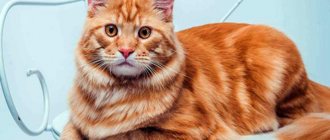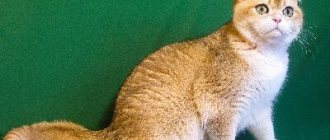History of the origin of the breed
Ojos azules (from Spanish Ojos azules) are representatives of the cat world, about which we can say that they are completely devoid of shortcomings. These American, blue-eyed kittens fall into the soul from the very first sight; not a single person can remain indifferent to a pet with such an intelligent and piercing gaze. Even Siamese do not always have rich blue eyes, more often white-blue or heavenly. It is believed that all cats with blue eyes are relatives of the Siamese or Angora to a greater or lesser extent. However, Ojos Azules does not have Siamese and Angora “impurities” and is a recognized cat breed in the world that carries the blue eye gene.
The first historical information about these unusually beautiful cats dates back to the late 70s of the last century. Around that time, in the American state of New Mexico, there lived the most ordinary and unremarkable yard cat and her name was Cornflower. She had an average body size, short tortoiseshell-colored fur - everything was like everyone else. But still, one feature was noticed in this cat - its eyes, it was they that attracted the attention of everyone who met the animal. They were painted in a superb, rich blue color - the color of the sea.
Ojos azules - cats with a delightful look
In 1984, geneticists confirmed that the “blue-eyes” living in the state of New Mexico carry a special, essentially unique gene. They conducted an experiment in which they crossed a cat with ordinary cats, and as a result it turned out that the mother’s color was passed on to the kittens, which means the gene was dominant. This scientific fact was taken into account, but the official standard for the new breed was drawn up and recognized 7 years later.
Fact! The genetic eye color of Ojos Azules is not related to the gene for body color or pattern. Therefore, these cats do not suffer from deafness and other problems related to eye color.
In 1991, a new breed was registered. It received the official name "Ojos Azules". Until now, the breed is at the stage of genotype formation.
Later it turned out that blue-eyed cats are found not only in America, but also in other parts of the world. For example, in the UK, Australia, New Zealand. But there are so few of them that by 1992, felinological organizations noted the presence of only 10 individuals. Traveling on ships as stray animals or as pets with their owners, they found themselves in new regions. Perhaps this is how attractive cats got to other continents.
Breeding Ojos Azules and organizing a nursery
First of all, every future breeder must receive an education. This is necessary not only in order to improve the breed and become one of the best in the business, but also in order to avoid making a fatal mistake that will lead to a genetic mutation or death of the kittens.
The required minimum includes:
- taking cat genetics courses;
- taking felinological courses;
- passing veterinary courses.
If you plan to participate a lot in exhibitions and be more than seriously involved in the activities of a breeder, you will also have to attend grooming and photography courses. Before exhibitions, professional care is necessary, and a trip to the salon can cost a considerable amount. It will also be necessary to photograph cats and kittens for advertising and the nursery website, and a trip to a photo studio or calling a photographer is also not the cheapest pleasure.
Beautiful and high-quality photography is not only the key to successful advertising, but also an indicator of the prestige of the nursery
The beginning of the way
So, you have received all the necessary education and are ready to become a breeder. The first step is to buy a cat. It is best to buy two at once - a male and a female, since there are no Ojos Azules nurseries in Russia yet. If space and experience allow you, you can take three animals - two cats and a cat. The cats will most likely have to be discharged from America. Find responsible and reputable breeders and come inspect the kittens for yourself. Only in this case will you be able to make the right choice.
What documents should breeding cats have:
- pedigree with permission to participate in breeding work;
- veterinary passport;
- purchase and sale agreement with the consent of the owner of the nursery for the participation of cats in breeding.
After cats come home, they need to be allowed to settle in for at least the first three months. During this time, you must register your nursery. To do this, you need to contact the representative office of the organization in which the breed is registered. It is best to contact your TICA office. There the name and seal of the nursery are registered, the breeding cats of the nursery are examined and entered into the documentation. After these procedures, you can get down to the breeding itself and related matters.
Mating and partner selection
You need to take care of choosing the right partner even at the stage of purchasing manufacturers. There are several rules for ojos azules:
- Under no circumstances should two completely blue-eyed cats be allowed to mate. In this case, kittens are born sick or non-viable.
- There are two more lines in the Ojos Azules breed: heterochromic cats and latent Ojos. The former have only one blue eye, the latter are not blue-eyed at all. When mating with heterochromes, 2/3 of the offspring will be born blue-eyed. When mated with ohi latent, half of the kittens will be blue-eyed, half will be heterochromic.
- If your choice fell on the ohi latent, remember: his eyes should be either green, yellow, or copper-colored.
- Partners should not be close relatives.
- Partners must be compatible not only genetically, but also by blood type. Cats have two of them - A and B. Compatibility scheme: Female A - male A or B.
- Male A - female A.
- Female B - male B.
- Male B - females A and B.
One of the partners must be either ochos latent or heterochromic
Before mating, you need to visit several exhibitions. There cats need to get a divorce appraisal. For cats, a rating of at least “excellent” is valid for a year; for cats, a rating of at least “very good” is also valid for a year. If the animal, after visiting several exhibitions, becomes a champion and closes the title, then the title certificate will be valid for life (but if the cat belongs to the latents, it can only receive a divorce appraisal). Cats can receive an assessment from the age of 8 months.
Before each mating, the cat and male must receive directions from the representative office where your cattery is registered. Referrals are issued on the basis of documents and divorce assessments/title certificates.
A cat can receive an assessment at a show from 8 months
Ojos' first estrus occurs between 8 and 10 months. Cats mature by one year. It is not advisable to breed cats at such a young age. Therefore, it is necessary to separate the animals during estrus until they reach the required age.
It is not recommended to breed cats before 1.5 years of age. Mating is carried out 2–3 days after the cat starts estrus. For a more successful result, animals need to be provided with complete peace and quiet, it is advisable to allocate a separate safe room.
It is not recommended to breed cats under 1.5 years of age
Pregnancy
Pregnancy can be determined with maximum accuracy in the third week. By this time, the cat’s nipples swell and become brighter, and her behavior and preferences change. A cat may even vomit in the morning, there is nothing wrong with that. More precisely, pregnancy can be determined by ultrasound.
Ojos Azules litters can have from 3 to 7 kittens. Their eyes open at 10–12 days, and their ears at 11–14. They weigh from 50 to 130 g, a stable increase per week is about 100–120 g.
Pregnancy in Ojos Azules usually lasts from 66 to 69 days
Appearance Standards
Determining whether a pet belongs to the Ojos Azules breed is not difficult for breeders, although at first glance, there is nothing special about such cats.
Color and coat type
Ojos Azules shorthair cats have soft, delicate and silky fur, clean and shiny. The undercoat is almost invisible, but in light colors it may be a little more abundant.
Long-haired cats have medium length, moderate density, and silky texture. A moderately thick collar and ruffles may be present, but this is not essential. The tail is completely feathered. The “pants” on the hind legs may be shaggy.
There is only one “bottleneck” in the color palette of the breed - the cat should not be white or Himalayan in color. Ojos azules always have at least one white spot on their body. They can be red, black, in solid, tortoiseshell and silver colors there may be spots on the paws, tip of the tail and on the muzzle, and if the tip of the tail is white, then white is also allowed in the main coat color.
Ojus azules black
Size and weight
Size can vary from medium to large, as can weight. All this depends on heredity, lifestyle and nutrition. On average, weight ranges from 3 to 5 kg, cats are slightly smaller than males. At the same time, height varies around 24-27 cm.
Anatomical features
| Head | Cats of this breed have a triangular head, resembling an isosceles triangle. The bridge of the nose, protruding chin and chin are clearly visible on the pretty face. |
| Ears | The ears are not very large in size and are set quite high. They are very wide at the base, narrowing noticeably towards the tip, the line of the tip of the ear is smoothly rounded. |
| Eyes | Eyes are the most important advantage of cats of the Ojos Azules breed. The eyes are located at an average distance, at a slight angle. In this regard, you might think that she has a slight squint, but, taking a closer look, it becomes clear that the cat is absolutely healthy, just such an unusual placement of the eyes. The shape has a beautiful almond-shaped configuration. As for the color of the iris, according to the breed standard, it can be presented in any shade of blue, from light blue like ice to deep blue. |
| Torso | Muscular, elastic, strong, elongated, graceful. Due to the developed muscle tissue, the cat appears stocky, but very flexible. The neck is slightly elongated. The chest is well developed. The tail is long, rounded at the tip, looks harmonious in combination with the body. The hip area is slightly raised above the line of the spine. |
| Limbs | The limbs are in harmony with the whole body, but the hind legs are slightly longer than the front ones. |
Ojos Azules - graceful and graceful
Description
Ojos azules are small, athletic-looking cats, stately and slender. Males of this breed reach a weight of 5 kg, females are lighter and more graceful. They are distinguished by their harmonious build and good health.
The body of these cats is slender, slightly elongated, with a well-developed chest. The hind limbs are longer than the forelimbs. Paws are oval, regular in shape. The tail is of medium thickness, pointed towards the very tip. The neck is graceful and elongated.
Animals of this breed are characterized by a special grace of body movements.
The head is triangular in shape, with a clearly visible bridge of the nose and a prominent chin. The pods are well developed. The ears are small, with rounded tips. Expressive eyes resemble the shape of an apricot kernel, most often bright blue. Sometimes there are cases of heterochromia: one eye is blue and the other is green or yellow.
The coat of these cats can be long or short. It is almost devoid of undercoat and does not hide the outlines of the animal’s body.
Due to the fact that the gene responsible for the blue eyes of Ojos Azules is dominant, blue-eyed cats can only be crossed with those representatives of the breed whose eyes are copper, golden or green. The offspring of blue-eyed individuals are born dead or with various types of defects: a deformed skull or a disproportionately short, curled tail.
From “marriages” with individuals whose eyes have any other shade, only half of the kittens will be blue-eyed, but all will be in excellent health.
Cats of this breed live up to 15 years, but good care, proper nutrition and lack of stress can extend your pet's life for several more years.
Character
The main psychological traits of attractive pets are a balanced temperament and a peaceful nature. Animals prefer peace and quiet to a greater extent. These animals are extremely kind, sometimes one gets the impression that the Ojos Azules simply radiate some kind of unearthly harmony and peace. They are very affectionate and friendly towards new people in the house. Sociability and at the same time love for the owner are perfectly combined in the character of the Ojos. At the same time, cats are very tactful: if a person is busy and does not pay attention to the pet, he will not bother you and demand attention to himself.
Ojos Azules are good with small children and can be a great friend for them, as long as the child does not behave inappropriately towards the cat.
As for other animals in the house, you don’t have to worry too much about their overall living; Ojos Azules can easily find a common language with other cats or dogs, and they will become bosom friends in no time, but it’s better to remove birds and, more importantly, rodents from his eyes. His hunting instincts, of course, do not rush out, but still, a cat is a cat and, having played too much, it can attack a hamster or a parrot, even if not out of malice, but the result of such a game may not be pleasant.
And even just looking at the photo of this cat, you can feel the warmth.
Ojos Azules is a gentle and peaceful creature.
Health
Unlike many artificially bred breeds, no genetic diseases have been identified in the breed! There is information from breeders that indicates that it is unacceptable to cross two blue-eyed cats! If you follow this nuance, the kittens are born healthy. All you need is to check your pet at least once a year with a veterinarian; a worm test is required every six months. When traveling out of town, protect the wool from pests by applying a special product or purchasing a collar.
Keeping and caring for a pet
Wool:
The difficulty of caring for an Ojos Azules depends on the length of its coat. But in general, caring for a cat is not difficult: its fur rarely gets tangled due to its silky texture, and its thin undercoat eliminates the need to clean the room every day.
- Comb out once every 2 days;
- For combing, it is better to use a slicker brush, and then a comb with rubber teeth;
- You can spray the wool with an antistatic agent;
- It is necessary to wash the cat once every 1.5 months;
Ears:
- Ear cleaning every 5 days;
- A few drops are placed in the cat's ear to clean the ears. Then the base of the ear is massaged for a minute.
- After this, wipe the auricle using a piece of natural fabric and ear cleaning gel.
Eyes:
- Cleaning the eyes involves daily wiping with a natural cloth applied to it with eye cleaning lotion, herbal decoction, or tea leaves or simply boiled water.
Teeth:
Cats of this breed often have problems such as the formation of tartar and inflammation of the soft tissues of the oral cavity, so hygiene is very important.
- You need to brush your teeth every 2 days;
- Use only a soft toothbrush and toothpaste;
- After the procedure, wipe your teeth with a soft cloth.
Claws:
- Provide your cat with a scratching post to prevent it from damaging the furniture;
- You can trim your claws as needed.
How to properly trim a cat's claws
Toilet
By nature, the Ojos Azules cat has excellent intelligence, and if these cats can be easily taught some tricks, then litter box training is a mere trifle for them, the main thing is to approach this issue correctly. Under no circumstances should you raise your voice at an animal, much less beat it, in this way you will achieve nothing but resentment and disappointment for your blue-eyed pet. If your kitten went to the toilet in a place other than the litter box, there is no need to panic; it would be best to sprinkle the area with lemon juice so that the cat does not go there again, and immediately take the culprit to the litter box and explain everything to him in an educational tone.
Ojos Azules - a clean breed
Rules of care
Ojos Azules cats are quite unpretentious in caring for them - communication and attention are more important for them. However, you still need to take care of your pet to keep it healthy and beautiful. Long-haired animals are a little more difficult to care for than short-haired ones. Caring for pets includes the following procedures:
- Bathing. It should be done regularly every two or three months. It is advisable to accustom your pet to water from childhood to reduce stress and effort.
- Combing. Unlike washing, this procedure is very pleasant for most cats. It must be carried out so that the wool does not pollute the house or apartment. Frequency: once every 3 weeks during the normal period and 2 times a day during molting.
- Cleaning eyes and ears. They must be regularly treated with cotton swabs or swabs. As a hygiene product, you can use ordinary purified water or special veterinary products sold in pharmacies and clinics. Contaminated areas must be thoroughly but gently rinsed, removing remaining sulfur, dirt, dust and dead mow particles. The procedure should be carried out about twice a week.
- Dental care. Representatives of this breed often suffer from tartar and inflammation of the oral cavity. Therefore, it is necessary to treat their teeth with a soft brush or a bandage wrapped around your finger. The device should be moistened in chamomile decoction or a special tooth powder should be applied to it, and then the pet’s teeth should be thoroughly treated. Some cats don't like it, but not all. As an alternative, special hygienic feeds can be used.
- Toilet training. These smart cats usually have no problem with this. They need to be raised the same way as all other cats. The litter in your pet's toilet should be changed regularly and kept away from the place where the animal eats and drinks.
- Nail trimming. Representatives of the breed do not need this procedure regularly - they only need to occasionally cut off too long nails that cause discomfort to the pet. These cats are not inclined to damage furniture or wallpaper, but there should still be a scratching post in the house.
- Selection of diet. In terms of food, these animals are also unpretentious; they have a fairly strong stomach. They can be fed lean meats, sea fish, offal, dairy products, vegetables and cereals. High-quality feed and vitamin and mineral supplements will also be included. The diet should consist mainly of protein foods. It is not recommended to feed a purebred cat with table scraps.
- Walks. These cats should not be allowed outside alone. If a balcony or enclosed yard is inaccessible, they will have to be walked like dogs. However, you don’t need to do this every day; 5-7 walks a month will be enough.
- Concern for safety. Before purchasing a cat, you should put nets on the windows and vents so that it does not fall out while trying to hunt birds or butterflies. It is also worth carefully monitoring the acquaintance of the peaceful Ojos Azules with children and other animals. Small pets should definitely be isolated from the cat - despite their calm nature, even a well-fed animal can harm them while playing.
Caring for cats of the Ojos Azules breed does not require much effort and time. Typically, all procedures take no more than a few hours a week. But all the rules regarding their content must be carefully followed, otherwise the animal will begin not only to feel unhappy, but also to get sick.
Diet selection
Ojos Azules has a good appetite. To maintain tone and natural activity, it is worth feeding in a balanced manner.
You can feed dry food. The food must be of high quality, with all the necessary microelements and vitamins. You can also feed natural food. But for good digestion, feed in a balanced manner, i.e. and dry food and natural food. Feed should be served separately from natural food: in the morning - dry food, for example, in the evening - natural food, or vice versa. Less carbohydrates and more proteins, i.e. meat.
An approximate ochos diet includes: 60% meat; 20% porridge; 10% vegetables and herbs.
What can you give from natural food:
- Meat: chicken, beef, veal, lamb, turkey;
- Vegetables: zucchini, pumpkin, beets, broccoli;
- Porridge: rice, millet;
- By-products: heart, lung;
- Boiled sea fish;
- Dairy products: low-fat kefir, fermented baked milk and cottage cheese (give no more than once a week), natural yogurt;
- Soft pork or beef bones and cartilage, but never chicken or fish.
What not to feed:
- Sweets;
- Salinity;
- Salty cheese;
- Smoked meats;
- Sausages and related products;
- Pork;
- Beef kidneys;
- Oily Fish;
- Egg white;
- Milk;
- Oil;
- Cream;
- Sour cream;
- Potato;
- Fruits;
- Legumes.
For dessert, additional vitamins must be given to a dish made from natural products.
Healthy vitamins should include:
- vitamin A, which is very beneficial for healthy skin, coat and vision;
- vitamin D, which has a good effect on the musculoskeletal system;
- vitamins C, E and B vitamins. They are beneficial for the cardiovascular and nervous systems;
- potassium, magnesium, zinc, iron, iodine, protein and yeast.
Proper nutrition will ensure good health for your cat.
Nutrition
The ancestors of blue-eyed cats lived on the street and ate whatever God provided. Their descendants are still distinguished by a strong stomach that can cope with any food. Of course, we are not talking about Olivier salad and cake with rich cream. The best food for your pet will be premium food containing all the necessary vitamins and microelements. If you prefer to feed him natural foods, ask your veterinarian what vitamins he needs.
The basis of the Ojos Azules diet should be meat: chicken, turkey, lean veal. Sometimes you can give boiled fish, but not more than once or twice a week. Occasionally they give scalded liver, kidneys, heart, lungs, turned through a meat grinder. Meat products are mixed with porridge, which is cooked from various cereals: rice, buckwheat, oatmeal. The most useful and easily digestible is buckwheat. It can reduce or completely eliminate the symptoms of stomach upset that sometimes occur when changing feeds.
Many cats of this breed love vegetables, including raw ones. There is no need to discourage this, even if your cat enthusiastically eats raw potatoes or cabbage leaves. Thus, it replenishes the lack of vitamins and cleanses the intestines. It’s better to sow grass for cats in a flowerpot and add more boiled vegetables to their food.
Interesting Facts
Many believe that all blue-eyed cats come from Siamese or Angora cats, known for the color of their eyes. However, the groans have nothing to do with them. Even despite the external similarity inherent in some representatives of the Ojos Azules breed with blue-eyed Siamese, these cats do not have a common origin.
Happy owners of Ojos Azules cats note their docile nature and ease of care.
They are very affectionate and get along easily with other pets. These are smart and understanding, calm animals, undemanding in care.
The only thing that the owners of Ojos Azules note is that it is almost impossible to purchase an elite kitten outside the United States, since there are simply no official nurseries in neighboring countries.
Diseases, breed defects
Owners of cats of the Ojoz Azules breed must take into account one feature when mating. Cats of the Ojos Azules breed cannot be crossed with each other, otherwise the owner risks getting sick, defective offspring with serious defects. It often happens that such matings result in dead kittens being born. It is best to breed Ojos with representatives of other breeds, then half of the offspring will have “correct” blue eyes.
Another part of the kittens will be rejected for coat color, but overall they will be healthy. The breed appeared quite recently; at the moment there is no data on diseases characteristic of this breed. Ojos azules have fairly good immunity and, with proper care and proper nutrition, can live 15-17 years, this is a very good indicator for a high-breed cat.
This is interesting! The breed has endurance and high resistance to characteristic genetic diseases. There is an opinion among experts that it is the characteristics of mating with other breeds that provide rich genetic material and, accordingly, good health for the cat.
Return to content
